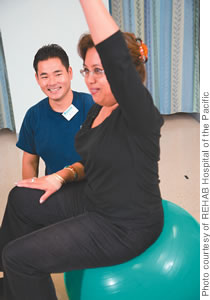
Battling Forces And Gravity
May 28, 2008
By Dr. Dennis Crowley


Dr. Dennis Crowley
Physiatrist
How long have you been practicing?
Since 1977 here in Hawaii.
Where did you receive your schooling and training?
I graduated with a B.A. in history at Berkeley, then I was at Creighton Medical School. I graduated from there, and then I had pediatric training at L.A. County and Tripler Army Medical Center. Then I had a fellowship in Family Child Health at the University of Washington in Seattle. Then I went into the rehabilitation residency in physical medicine and finally finished school in 1976.
{embed=“elements/box_ad”}
What is an average day at work like?
My day at work is focused on helping establish diagnoses for neurological and neuromuscular-skeletal conditions. I deal with bones and nerves and how they impact function and performance.
What are some of the more common injuries you see on a daily basis?
People with neck pain and back pain, as well as joint pains - mainly in their shoulders, hips and knees.
What are those pains usually caused from?
I tell people that life is a battle against forces and gravity. The big culprit is friction. The simplest friction condition we’re familiar with is a blister. Arthritis is basically a joint blister where you end up having two bones at a joint and, as they move, friction develops. The anatomic design tries to reduce that, where all our joints have some fluid in them and they have cartilage. But, with time, those things can decrease and, as that happens, friction becomes a problem. It shows itself in the form of pain.

|
Are a lot of the pains that you see preventable?
We have limited control over our health, but the area we do have control of is what we put inside our bodies and how we exercise.
One of the keys to rehabilitation is the promotion of function through exercise and through stretching.
What’s the approach taken when a patient comes in for treatment?
The approach is the medical model of having characterizations or descriptions of the symptoms. The symptom presentation by the patient is really critical because the words help form the pieces of the puzzle.
The more definitive those pieces are, the easier it is to know what the diagnosis is going to be.
Beyond that there are other factors. In some cases, there may be insomnia or high stress, or there may be personal conflicts that heighten muscle tone or that put people in high physical demands that are beyond the person’s capabilities. I tell a lot of my patients that we all have limited stress capabilities and if you exceed a physical stress capacity, something has to give. And we all know, too, that in life, we have repetitive stress. Over and over we’re pounding the ground and, if we’re doing a lot of manual work, it’s a lot of repetitive force and friction.
{embed=“elements/google_ad336x280”}
Do you see both adults and children?
It’s mostly adults, but we also see children. Usually the youngest age is about 10 years old.
In your opinion, what area in your field has the most room for improvement?
Well, people’s awareness of what we do. If you mention you’re a physiatrist, that does-n’t connect with a lot of people. My mom never quite knew what kind of specialist I was.
What do you think is the future of physiatry?
I think that its relevancy will definitely increase as humankind’s maladies continue to act on decreased function and ability. That’s the one kind of aspect of care that the initial people who established the specialty realized. They realized that recovery is much more than surgery or taking medicines. What’s critical is to promote function, and as you promote function you promote recovery and you promote fitness. That’s why we work so much with the physical therapists and occupational therapists. I just think that with the aging population, there will be plenty of time and need.